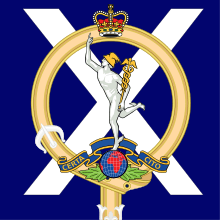32 (Scottish) Signal Regiment
The 32nd Signal Regiment is a British Army Reserve Regiment of the Royal Corps of Signals. The regiment forms part of 51st Infantry Brigade and Headquarters Scotland, providing military communications for national operations.
| 32nd Signal Regiment | |
|---|---|
 Emblem for 32nd Signal Regiment | |
| Active | 1967 - Present |
| Country | |
| Branch | |
| Type | Royal Corps of Signals |
| Role | National Resilience Communications Regional RPOC Support |
| Size | Four squadrons |
| Part of | 51st Infantry Brigade and Headquarters Scotland |
| Garrison/HQ | RHQ 32 Signal Regiment - Glasgow 2 (City of Dundee) Signal Squadron - Dundee & Aberdeen 40 (North Irish Horse) Signal Squadron - Belfast 52nd (Support) Squadron - Glasgow 51st (Scottish) Signal Squadron - Edinburgh & East Kilbride |
| Motto(s) | Certa Cito (“Swift and Sure”) |
| Colors | Sky Blue, Navy and Green (Air, Sea and Land) |
| March | Quick - Begone Dull Care Slow - H.R.H. (Princess Royal) |
| Mascot(s) | Mercury (“Jimmy”) |
| Commanders | |
| Current commander | Lt Col IA Davidson VR |
| Insignia | |
| Tactical Recognition Flash |  |
| Tartan | .png) |
History
Early history
1st Lanarkshire Voluntary Military Engineers was raised in Glasgow on 5 December 1859 as part of the Volunteer Force.[1] In 1894, the Telegraph Company, 2nd Lanarkshire Volunteer Military Engineers was assigned to the unit.[1]
First World War
As part of the 1908 Haldane Reforms, the unit became the Lowland Divisional Telegraph Company.[2] A Wireless, Cable and Airline unit was assigned to the unit and the regiment was established as a Field Company to support 51st (Highland) Division. After the outbreak of World War I in 1914, the regiment was sent as part of IV Corps and the British Expeditionary Force to France.[1]
Second World War
During World War II, the regiment again saw active service, providing support to both 51st (Highland) Division and 52nd Lowland Divisions. In 1947, the regiment returned once again to Maryhill and was re-titled as the 51st/52nd (Scottish) Infantry Division Signal Regiment.[2] It was further re-titled 52nd Lowland Infantry Division Signal Regiment in 1948.[2]
Post War
As a result of the 1966 Defence White Paper, the 32nd (Scottish) Signal Regiment was formed on 1 April 1967. The new regiment composed of five squadrons, amalgamating the four signals regiments in Scotland. They were as follows:[3]
- Headquarters Squadron
- 51st (Highland) Signal Squadron - successor to 51 (Highland) Signal Regiment
- 52nd (Lowland) Signal Squadron - successor to 52 (Lowland) Signal Regiment
- 61st (City of Edinburgh) Signal Squadron - successor to 61st (City of Edinburgh) Signal Regiment
- 82nd (Army Emergency Reserve) Signal Squadron - successor to 82 Signal Regiment (Army Emergency Reserve)
The regiment gained a sixth squadron in 1969, whereby a squadron of North Irish Horse became 69 (North Irish Horse) Signal Squadron.[3] From 2009 to 2014 33 Lancashire Signal Squadron formed part of 32 Regiment before it was transferred to 37 Signal Regiment under the Army 2020 reforms.[4]
In October 2010, 69 (North Irish Horse) Signal Squadron returned to the regiment as 40 (North Irish Horse) Signal Squadron.[5] Then under the Army 2020 re-organisation, 2 (City of Dundee and Highland) Squadron was transferred from 38 Signal Regiment.[6]
Structure
The regimental headquarters is situated in the West End of Glasgow and has four squadrons based in Scotland and Northern Ireland:[7]
- 2 (City of Dundee & Highland) Signal Squadron - Dundee & Aberdeen
- 40 (North Irish Horse) Signal Squadron - Belfast
- 51 (Highland) Signal Squadron - Edinburgh & East Kilbride
- 52 (Lowland) Support Squadron - Glasgow & York
The regiment is part of 1 Signal Brigade.
References
- Lord and Watson, p. 163
- "Lowland Signals, Royal Corps of Signals". Regiments.org. Archived from the original on 19 April 2007. Retrieved 19 November 2017.
- "32nd (Scottish) Signal Regiment, Royal Corps of Signals". Regiments.org. Archived from the original on 5 March 2007. Retrieved 19 November 2017.
- "Explore the Reserves - Royal Corps of Signals". Retrieved 11 May 2019.
- "69 (North Irish Horse) Signal Squadron". Signals Badges. Retrieved 19 November 2017.
- "Summary of Army 2020 Reserves structure and basing changes" (PDF). Ministry of Defence. Retrieved 19 November 2017.
- "32nd Signal Regiment". Ministry of Defence. Retrieved 19 November 2017.
Bibliography
- Lord, Chris; Watson, Graham (2004). The Royal Corps of Signals: Unit Histories of the Corps (1920-2001) and its Antecedents. Helion. ISBN 978-1874622925.